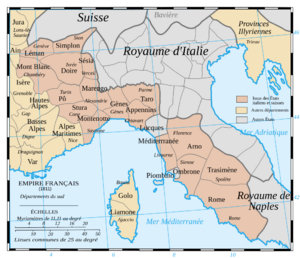Rome (department) facts for kids
Quick facts for kids Département de Rome |
|||||||||
|---|---|---|---|---|---|---|---|---|---|
| department of the First French Empire | |||||||||
| 1809–1814 | |||||||||
|
|
|||||||||
 Administrative map of the Italian portion of the French Empire. |
|||||||||
| Capital | Rome | ||||||||
| Area | |||||||||
| • Coordinates | 41°54′N 12°30′E / 41.900°N 12.500°E | ||||||||
|
• 1812
|
3,676.6 km2 (1,419.5 sq mi) | ||||||||
| Population | |||||||||
|
• 1812
|
586,000 | ||||||||
| History | |||||||||
|
• Annexion from the Papal States
|
17 May | ||||||||
|
• Name changed from Tibre to Rome
|
17 February 1810 | ||||||||
| 1814 | |||||||||
| Political subdivisions | 6 Arrondissements | ||||||||
|
|||||||||
The Department of Rome was a special area, like a province, that belonged to the First French Empire. This empire was led by Napoleon and covered much of Europe in the early 1800s. The Department of Rome was located in what is now Italy. It was named after the famous city of Rome.
This area became part of France on May 17, 1809. Before that, it was known as the Papal States, which were lands ruled by the Pope. When France took control, the area was first called the Département du Tibre, named after the Tiber river. On February 17, 1810, its name was changed to the Department of Rome. Napoleon even gave his son, Napoleon II, the special title of King of Rome.
The Department of Rome stopped existing in 1814 after Napoleon was defeated. The Papal States were then given back to Pius VII, who was the Pope at the time. Today, the land that was once the Department of Rome is mostly the Italian region of Lazio.
How Rome Was Organized
The Department of Rome was divided into smaller areas called arrondissements. These were like counties or districts. Each arrondissement was then split into even smaller parts called cantons. This system helped the French Empire manage the area.
Main Arrondissements
In 1812, the Department of Rome had six main arrondissements:
- Rome: This was the most important arrondissement. It included the city of Rome and several surrounding cantons like Bracciano, Civitavecchia, Frascati, Marino, Morlupo, and nine cantons within Rome itself.
- Frosinone: This arrondissement had many cantons, including Alatri, Anagni, Ceccano, Ceprano, Ferentino, Filettino, Frosinone, Guarcino, Monte San Giovanni, Prossedi, Ripi, Supino, Vallecorsa, and Veroli.
- Rieti: Its cantons included Canemorto, Castelvecchio, Magliano, Monteleone, Narni, Poggio Mirteto, Rieti, Stroncone, and Torri.
- Tivoli: This area included cantons like Anticoli, Monterotondo, Olevano, Palestrina, Palombara, Subiaco, Tivoli, and Vicovaro.
- Velletri: Its cantons were Albano, Cori, Genzano, Paliano, Piperno, Segni, Sermoneta, Sezze, Terracina, Valmontone, and Velletri.
- Viterbo: This arrondissement had cantons such as Bagnorea, Canino, Caprarola, Civita Castellana, Corneto, Montefiascone, Orte, Ronciglione, Sant'Oreste, Soriano, Toscanella, Valentano, Vetralla, and Vignanello.



